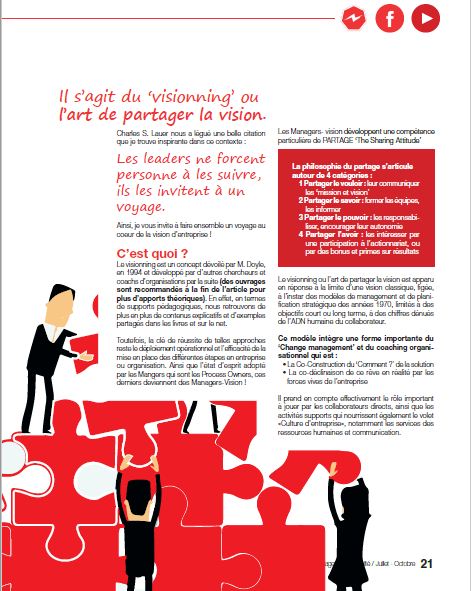Dare to Dream—and Inspire Your Team to Dream withYou
What is company vision really about?
It’s more than just a strategic objective. It’s the founding dream—theultimate driver that fuels leadership and gives direction to teams.
In leadership coaching sessions, we often startwith two simple but powerful questions:
- What is your dream for this company?
- And what do your teams think about it?
These questions matter more than ever, especiallyin today’s volatile economy, where performance, KPIs, and market sharedominate and leaders are under constant pressure from global and localforces alike.
So how can you, as a manager, reignite thespark of purpose in your teams?
Introducing “Visionning”: The Art of VisionSharing
Coined by Michael Doyle in 1994, the concept of visionninggoes beyond static mission statements. It’s a dynamic, evolving processthat helps managers co-create and communicate a compelling vision—one thatresonates emotionally and strategically.
As Charles S. Lauer famously said:
“Leaders don’t force people to follow—they invitethem on a journey.”
The Visionning Philosophy: 4 Levels of Sharing
1. Share the “Will”
Communicate the company’s mission and vision clearly and passionately.
2. Share the “Know-how”
Train and inform your teams to align skills with strategic goals.
3. Share the “Power”
Empower employees by encouraging autonomy and accountability.
4. Share the “Rewards”
Offer incentives, bonuses, or even equity to align interests and fuelengagement.
This modern leadership framework replaces outdatedtop-down strategies from the 1970s. It’s more human, more agile, and rooted in organizationalcoaching and change management.
A Systemic, Human-Centric Approach
Visionning is not just a strategy—it’s a culturaltransformation that:
- Aligns strategy with emotional intelligence
- Connects dreams to daily actions
- Involves all departments, not just executive leadership
- Turns abstract ambitions into behavioral habits across the company
Important note: Employees are more likely toembrace a vision when they feel it emotionally—not when it's written on aboardroom wall.
The 3-Step Visionning Process
At Coachinglab, we guide companies through threekey stages:
1. Today: The Starting Point
Facilitated by an experienced coach, this phaseinvolves aligning all stakeholders on the core fundamentals: mission,vision, ambition, and values.
2. SWOT Diagnosis
Evaluate the current environment andinternal capacity. Cross-functional teams collaborate to identify sharedconclusions.
3. Projection into the Future
Define strategic actions and goals to bring thevision to life. Each department crafts its own action plan with specific KPIsto track impact.
Definitions for Clarity
- Mission: Why your organization exists
- Vision: The dream, the desired future state
- Ambition: The long-term challenge (market share, revenue, size, etc.)
- Values: The guiding principles that shape your culture
- Objectives: SMART actions (Specific, Measurable, Achievable, Realistic, Time-bound)
Tangible Outcomes
Companies that embrace visionning report:
- Stronger team cohesion
- Better communication
- Recognition of individual contributions
- A surge in innovation
- Increased autonomy across departments
And best of all—it’s not a one-time initiative. Itevolves co-constructively over time.


